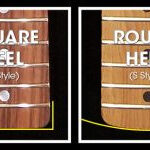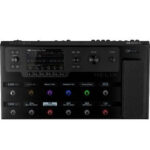Emerald Guitars, hailing from Ireland, has carved a niche for themselves with their innovative use of carbon fiber in guitar construction. Drawing inspiration from high-end carbon fiber racing boats, they craft instruments that are not only visually striking but also sonically exceptional. This isn’t your run-of-the-mill carbon fiber; Emerald’s guitars are engineered for superior sound projection. In blind tests, many listeners are surprised to learn they aren’t made of wood, a testament to their remarkable sound quality. Having already experienced the brilliance of two Emerald guitars – the Synergy X20 Harp guitar and the Chimaera double neck – I was eager to explore the Virtuo model. Lured by a compelling sale, I decided to add the Virtuo to my collection.
Like its Emerald siblings, the Virtuo boasts a full carbon fiber construction – body, neck, and fingerboard. Stainless steel frets add to its durability and crisp tone. This hollow body guitar is equipped with a pair of Fishman Fluence humbucker pickups. Familiar with Fluences from my Strandberg 7 and 8 string guitars, I appreciate their versatility, though I personally lean towards the vintage voicing over the modern option. For acoustic tones, the Virtuo incorporates a Graph Tech Ghost Piezo system, featuring individual pickups for each string, promising a more natural acoustic sound. Additionally, a 13-pin MIDI connector opens doors to guitar synth integration, although this is a feature I haven’t personally explored.
My Virtuo features a custom finish: a thin veneer of Amara Ebony, dyed red, atop the carbon fiber body. The image below showcases the natural beauty of undyed Amara Ebony on a Virtuo. The guitar is remarkably lightweight and visually stunning. Control-wise, it offers a dedicated volume for the humbuckers, a tone control for the humbuckers, a volume for the piezo system, and a synth volume control. A three-way selector switch manages the humbuckers, and another three-way switch selects between humbuckers only, piezo only, or a blend of both. The output jack is designed for versatility: a standard mono TS cable outputs a mix of both pickup systems, while a TRS to dual TS adapter allows for separate outputs, ideal for routing the acoustic signal to an acoustic amplifier and the electric signal to an electric amp. This split output configuration truly unlocks the Virtuo’s potential, delivering exceptional tones through dedicated amplification.
The Virtuo is equipped with 18:1 Gotoh 510 tuners, known for their smooth and precise operation, eliminating any tuning frustrations. The 22 frets are flawlessly finished, with no fret sprout and expertly polished fret ends. The cutaway body design provides effortless access to the higher frets, making lead playing a breeze. The guitar arrived strung with D’Addario strings and protected in a Hiscox hard case, ensuring its safety during transport and storage.
Optimizing the Virtuo for Peak Performance
While the Virtuo is a genuine hollow body guitar, its acoustic sound, when played without amplification, is somewhat understated. This is partly due to the presence of electric strings, the shallow body depth, and the integrated electronics. To enhance its acoustic capabilities, I installed a D’Addario tuner inside the soundhole, a process detailed in this article: How to Install a Tuner in Your Acoustic Guitar.
The Virtuo’s TRS output jack offers flexible routing options. Using a standard TS guitar cable merges the signals from the humbuckers and piezo, allowing you to control the blend using their individual volume knobs. The micro-switch further allows you to isolate either pickup system. However, to fully capitalize on the Virtuo’s dual nature, I employ a TRS plug that splits into two TS jacks. I route the humbucker signal to a Wet/Dry rig consisting of two Fender Hot Rod Deluxe IV amplifiers, each loaded with Celestion Creamback speakers. The “dry” side of this rig includes an Effectrode LA-2A Compressor, an Effectrode Mercury Fuzz, a Browne Protein, and a JHS Packrat, offering a versatile palette of overdrive and distortion tones. The “wet” side features a Strymon Lex, a UA Astra, a UA Starlight, and a UA Golden Reverberator, providing lush modulation and reverb effects. This meticulously crafted setup has evolved over time and delivers exceptional electric guitar tones.
Crucially, the piezo signal, unlike many typical piezo systems, avoids the harsh, nasal qualities often associated with them. I send the piezo output directly to an AER Tommy Emmanuel Compact 60 acoustic amplifier. This is my preferred acoustic amp, used with neutral settings and just a touch of built-in reverb to add spaciousness. Remarkably, the Ghost Piezos in the Virtuo are so natural sounding that I no longer need my usual piezo-enhancing pedalboard, which includes an Empress Mark II Compressor, Source Audio EQ2, and TC Electronic BodyRez. If you’re considering piezo pickups, the Graph Tech Ghost Piezos are, in my experience, the only ones worth considering for truly acoustic-like tones. I set my maximum output volume on the amplifiers and then use the individual volume controls on the Virtuo to fine-tune the balance between the electric and acoustic signals.
The Fishman Fluence pickups offer further tonal flexibility, allowing you to switch between vintage and modern voicings via push-pull controls. Each pickup can also be coil-split for brighter, single-coil sounds. Over time, the Fishman Fluences have grown on me, and I find them incredibly versatile and expressive in the Virtuo, contributing significantly to its status as a truly Best Sounding Acoustic Electric Guitar. The control diagram above illustrates the comprehensive and intuitive layout of the Virtuo’s electronics.


